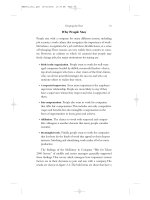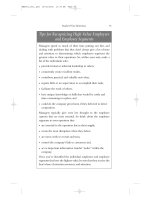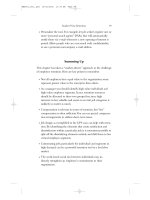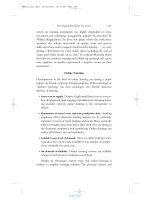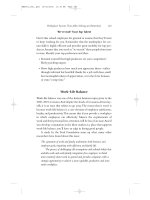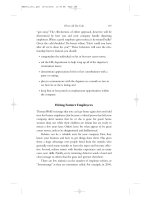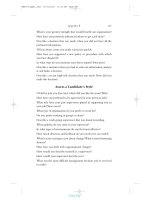Tài liệu Hiring and Keeping the Best People 2 doc
Bạn đang xem bản rút gọn của tài liệu. Xem và tải ngay bản đầy đủ của tài liệu tại đây (145.21 KB, 8 trang )
Hiring and
Keeping the
Best People
HBE001_fm_.qxd 10/02/2002 11:27 AM Page ix
This Page Intentionally Left Blank
Introduction
This book explains the essentials of what managers and business
owners need to know about hiring and retaining good employees.
Effective hiring and personnel retention are the two bases of future
organizational well-being. If that seems like an overstatement, con-
sider this: The success of most of today’s businesses depends more on
human assets than on physical or financial assets. Buildings, equip-
ment, manufacturing facilities, and most technologies can be readily
purchased,but the human talent and know-how needed to drive our
knowledge-based industries are much harder to come by.
Hiring decisions are among the most important decisions made
by managers, and this book explains the essentials of what managers
and business owners need to know about this process.Without the
right people in the right positions, neither a company nor its in-
dividual units can turn in exceptional performance. Good hiring
decisions create a foundation for more effective performance by
employees, teams, and the company overall. Conversely, bad hiring
decisions drag down performance and are painfully expensive to
correct. Bradford Smith, a consultant who helps major corporations
with their hiring decisions, has estimated from his study of fifty-four
U.S. companies that the average managerial “mis-hire” costs a com-
pany twenty-four times the individual’s base compensation!
1
How is
that possible? Smith points to all the usual suspects: the mis-hire’s
compensation and cost of maintenance, the initial hiring cost, sever-
ance expenses, the costs associated with hiring and training a
replacement, and so forth. But the biggest cost, according to Smith,
is the cost of the mistakes, failures, and missed business opportunities
xi
HBE001_fm_.qxd 10/02/2002 11:27 AM Page xi
TEAMFLY
Team-Fly
®
that result from having the wrong person in a management position
over several years.Thus, in his calculation, the average total cost for a
mis-hired manager with a base compensation of $114,000 will cost
a company $2.7 million in not just tangible fees, but the intangible
expenses of errors and lost opportunities.
The damage that mis-hired or mis-placed individuals can cause
is particularly acute when they are managers. C-level managers typ-
ically hire C-level players, set lower standards, and eventually create
an exodus of truly competent people.When excellent managers and
great employees are hired, the opposite prevails. Thus, hiring man-
agers have a powerful obligation to their company and to themselves
to treat hiring with the greatest attention and to be as deliberate as
possible in identifying and engaging the best possible people. David
Oglivy summed up the importance of careful hiring when he wrote,
“If each of us hires people who are smaller than we are, we shall
become a company of dwarfs. But if each of us hires people who are
bigger than we are, we shall become a company of giants.”
Retention is the other side of the human asset equation. In a
market-driven economy you’ll never be able to keep everyone—and
you shouldn’t want to.A certain amount of employee turnover can
actually improve the health of an organization, infusing new energy
and new ideas into the ranks. But turnover among valued employ-
ees is costly, disruptive, and negatively correlated with customer sat-
isfaction.As this book will reveal, hiring right is a powerful first step
in reducing unwanted turnover.But there are many other things you
can do to make your workplace one that good people will not want
to leave, and these will be addressed here in detail.
What’s Ahead
As a manager responsible for hiring decisions, this Harvard Business
Essentials volume will provide you with the basics of hiring and
retaining great people.
Chapter 1 begins with a five-step process for effective hiring,
from determining the job requirements to recruiting, interviewing,
and evaluating candidates, and making an offer.
xii Introduction
HBE001_fm_.qxd 10/02/2002 11:27 AM Page xii
Chapter 2 digs deeper into key steps of the hiring process. Using
a conceptual framework of “embedded life interests,” it will help
you align individuals with jobs that they will find most satisfying and
at which they will excel.The chapter also covers the pros and cons of
timely subjects such as online recruiting, the use of “head hunters”
and search firms, candidate testing,and the case interview technique.
In Chapter 3, we move from hiring to the field of employee
retention. Distilling recent research findings, we will explore why
retention matters—as measured by customer satisfaction, turnover
costs, and business performance. This chapter explains, in broad
strokes, why people stay with a company and why they leave, and
points to eight practical steps that managers can take to improve
retention.
Chapter 4 looks at the retention challenge from a market per-
spective. From this perspective, some employees and employee seg-
ments represent more value to the organization than others. The
market perspective suggests that managers should be less concerned
about overall turnover and more concerned with focusing retention
attention and resources on those individuals and employee segments
that create the most value for the organization.This chapter explains
how various market-based strategies can reduce turnover amongst
these key individuals and employee segments.
Training and career development are also shown to be effective
tools for the retention of valued employees. Chapter 5 describes for-
mal and informal approaches to employee training, explains why
training pays, and offers tips on reducing its costs through online
learning. In addition to boosting retention, many of your organiza-
tion’s human resource needs can be cultivated internally through
employee development—specifically, skill training and career devel-
opment—and this chapter will also address this key benefit.
The effect of the workplace environment on hiring and reten-
tion is the subject of Chapter 6.This chapter not only explains how
workplace climate can influence a candidate’s decision to take a job
and to stick with it, but also addresses how you can alter the culture
of your workplace to make it more appealing and to avoid employee
burnout. Also discussed are three principles for creating successful
work-life balance programs.
Introduction xiii
HBE001_fm_.qxd 10/02/2002 11:27 AM Page xiii
Even if you handled every aspect of hiring and retention per-
fectly, you would still lose some valued employees.This is a fact of
life in a free labor market. But as Chapter 7 reveals, the departure of
a good employee need not be the end of your productive relation-
ship with that individual.This chapter shows how some professional
service firms are using alumni relations programs to keep former
employees in their orbits as customers, sources of market intelli-
gence, and, in some cases, as future “rehires.”The benefits of rehires,
and of using exit interviews to uncover the root causes of employee
turnover, are also explored in this final chapter.
In our mission to cover the “essentials” of hiring and retention,
we’ve naturally been able to touch only lightly on many subjects and
have left others out entirely. So, for readers who would like to learn
more, a number of helpful resources are included at the end of this
book: a glossary of terms, an annotated list of relevant articles and
books, and three appendices.Appendix A contains a job description
that you can use as a model in developing your own descriptions.
Appendix B is a generic group of questions that you can use as you
interview candidates for just about any type of job. Appendix C
describes the “legal landmine” that readers based in the United
States need to be aware of, and avoid, in the hiring process.
In addition, you will find invitations throughout the book to
visit the official Harvard Business Essentials Web site, www.elearn-
ing.hbsp.org/businesstools, for free interactive versions of the tools
introduced in this book.
The content in this book is based on a number of books,articles,
and online productions of Harvard Business School Publishing, in
particular: Peter Cappelli’s Harvard Business Review article on mar-
ket-driven retention; various hiring and retention articles published
in Harvard Management Update; and the hiring module found in Har-
vard ManageMentor®, an online service.
While this book will help you improve your hiring and
employee retention skills, the information given here is of a general
nature and is not intended as legal advice nor as a substitute for legal
consultation regarding general hiring processes or the management
of specific individual situations.With that caveat in mind, let’s turn
to the five-step hiring process.
xiv Introduction
HBE001_fm_.qxd 10/02/2002 11:27 AM Page xiv
The Hiring Process
Attracting the Best People
1
Key Topics Covered in This Chapter
•
Defining job requirements
•
Recruiting promising candidates
•
Interviewing
•
Evaluating candidates
•
Making the decision and offer
HBE001_ch1_.qxd 10/03/2002 2:47 PM Page 1
L
ike many othe r activities undertaken by organiza-
tions, hiring is a business process—a set of activities that
turn inputs into outputs.This process compiles informa-
tion about job requirements, the applications of various candidates,
and the deliberations of decision makers, and produces an outcome:
new people on the payroll.This chapter describes a five-step hiring
process. Execute these steps well, and not only will the quality of
your hires improve, but you will also be more confident that you are
hiring the right people.
Defining Job Requirements
Before you can make a good hire, you need to know what you are
hiring for. You also need to determine which skills and personal
attributes will be a good “fit” with the requirements of the job and
the organization.
To define the job and its requirements, you need to understand:
•
the primary responsibilities and tasks involved in the job;
•
the background characteristics needed to perform the job
(education and experience);
•
the personal characteristics required (for example, does the
individual need to have strong interpersonal skills? Be highly
intelligent?);
HBE001_ch1_.qxd 10/03/2002 2:47 PM Page 2
